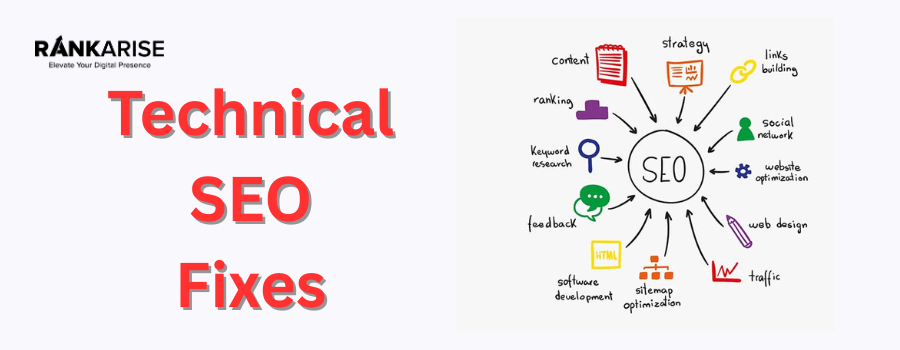Technical SEO is often approached as a checklist of rankings-boosting tweaks. However, the most impactful technical SEO efforts are those that drive measurable business outcomes mostly revenue by improving user experience, site performance, and conversion pathways. Applying the 80/20 principle to technical SEO means focusing on the critical 20% of fixes that generate 80% of revenue impact. Here are 12 technical SEO fixes proven to move the needle on revenue, complete with analytics insights and examples.
1. Site Speed Optimization
Why It Matters:
Slow sites increase bounce rates and reduce conversions, directly hitting revenue.
Analytics Insight:
Pages loading in under 2 seconds have 50% higher conversion rates compared to pages loading over 3 seconds (Google/SOASTA).
Fixes:
- Compress images without compromising quality.
- Minimize JavaScript and CSS blocking rendering.
- Use a content delivery network (CDN).
Example:
An eCommerce site improved load time from 4s to 1.8s and saw a 20% increase in checkout completions.
2. Mobile Usability and Responsiveness
Why It Matters:
Mobile traffic accounts for over 60% of web traffic; a poor mobile experience means lost customers.
Analytics Insight:
Google users are 5 times more likely to abandon if the site isn’t mobile-friendly (Google/Mobify).
Fixes:
- Responsive design with accessible touch targets.
- Fast mobile load times.
- Simplified navigation for small screens.
Example:
A SaaS startup optimized mobile UX and increased free trial signups by 35%.
3. Fix Crawl Errors and Broken Links
Why It Matters:
Broken links and crawl errors waste crawl budget and frustrate users.
Analytics Insight:
Sites with significant crawl errors see lower organic traffic growth (Ahrefs).
Fixes:
- Use Google Search Console to identify and fix 404s.
- Redirect or remove broken links.
- Fix server errors (5xx).
Example:
A publisher fixed 300+ 404 errors, increasing organic traffic by 12% and ad revenue by 18%.
4. Optimize XML Sitemap and Robots.txt
Why It Matters:
Clear sitemaps help search engines index high-value pages timely.
Analytics Insight:
Pages submitted via XML sitemaps are indexed 1.5x faster (Moz).
Fixes:
- Include only canonical URLs.
- Remove noindex or blocked pages.
- Regularly update sitemap.
Example:
An online retailer’s sitemap cleanup resulted in 15% increase in indexed product pages and a 7% uplift in sales.
5. Implement Structured Data Markup
Why It Matters:
Rich snippets improve CTR by enhancing SERP appearance.
Analytics Insight:
Structured data can increase click-through rate by up to 30% (Search Engine Journal).
Fixes:
- Use schema.org for products, reviews, FAQs.
- Test markup with Google’s Structured Data Testing Tool.
- Monitor for errors in Search Console.
Example:
A restaurant chain saw a 25% increase in reservation clicks after implementing schema markup.
6. Ensure HTTPS and Secure Website
Why It Matters:
Security is a ranking factor and builds trust for conversion.
Analytics Insight:
Sites with HTTPS enjoy better SEO rankings and 70% of users avoid non-secure sites (Moz, HubSpot).
Fixes:
- Implement SSL across all pages.
- Redirect HTTP to HTTPS.
- Fix mixed-content warnings.
Example:
A fashion retailer saw a 15% increase in conversions after switching to HTTPS.
7. Use Canonical Tags to Avoid Duplicate Content
Why It Matters:
Duplicate content dilutes ranking signals and wastes crawl budget.
Analytics Insight:
Correct canonicalization improves ranking consistency and organic traffic (Screaming Frog).
Fixes:
- Add rel=canonical tags on similar content.
- Address URL parameter issues.
- Avoid duplicate meta tags.
Example:
A B2B site consolidated product variations, improving page authority and doubling lead submissions.
8. Optimize Pagination and Infinite Scroll
Why It Matters:
Proper pagination helps search engines index content and users find products easily.
Analytics Insight:
Poor pagination leads to crawling issues, reducing rankings on category pages (Google Webmaster Guidelines).
Fixes:
- Use rel=next/prev tags or load more buttons.
- Ensure paginated pages have unique titles and meta descriptions.
- Avoid endless infinite scroll without SEO fallback.
Example:
An eCommerce site improved category page rankings and conversions by implementing crawlable pagination.
9. Fix Redirect Chains and Loops
Why It Matters:
Redirect issues slow down page load and confuse crawlers.
Analytics Insight:
Pages with redirect chains lose up to 50% link equity and suffer slower indexing (Ahrefs).
Fixes:
- Remove chains by redirecting original URL directly to final URL.
- Fix infinite redirect loops.
- Use 301 redirects appropriately.
Example:
After redirect cleanup, a SaaS company improved organic traffic by 20% and enhanced crawl efficiency.
10. Clean Site Architecture and URL Structure
Why It Matters:
Clear, shallow structures improve crawlability and user experience.
Analytics Insight:
Sites with deeper URL structures (>3 levels) have 15% higher bounce rates (Backlinko).
Fixes:
- Organize important pages within 3 clicks from homepage.
- Use descriptive, keyword-rich URLs.
- Avoid excessive parameters or session IDs.
Example:
Tech blog redesigned URL hierarchy and saw a 15% increase in time on site and ad revenue.
11. Optimize Server Response Codes
Why It Matters:
Proper response codes ensure search engines interpret pages correctly.
Analytics Insight:
Mismanaged response codes can lead to lost rankings and traffic (Google).
Fixes:
- Ensure 200 for live pages.
- Use 404 for missing pages, 410 if permanently removed.
- Fix soft 404s.
Example:
Tourism site correctly fixed 404s and improved organic visits by 9%.
12. Monitor and Improve Core Web Vitals
Why It Matters:
Google uses Core Web Vitals as ranking signals that affect UX and conversions.
Analytics Insight:
Sites with good Core Web Vitals show an average 7% increase in organic traffic (Google Data).
Fixes:
- Optimize Largest Contentful Paint (LCP).
- Reduce cumulative layout shift (CLS).
- Improve First Input Delay (FID).
Example:
Media website optimized LCP and cut CLS, resulting in 15% higher ad revenue.
Conclusion
Investing in these 12 technical SEO fixes drives not just rankings, but tangible increases in user engagement, conversion rates, and ultimately revenue. By applying the 80/20 rule, focusing on these high-impact tasks leads to outsized returns for SEO efforts. Whether you manage eCommerce, lead generation, or content sites, aligning technical SEO with business outcomes ensures meaningful success.

